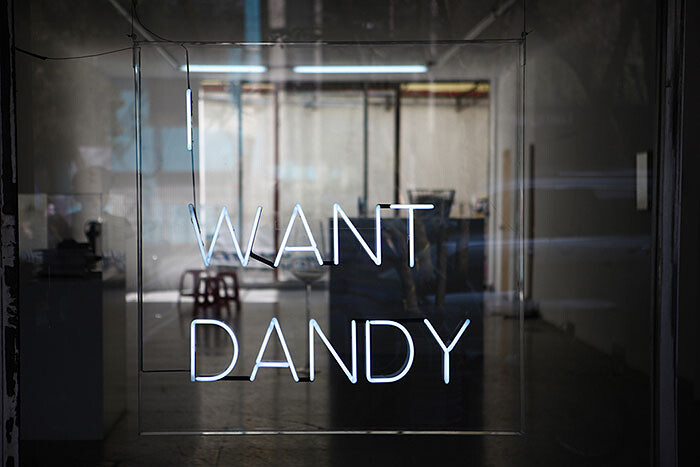“I WANT DANDY.” There’s no denying that it’s appealing, even catchy, not as catchy perhaps as the maddeningly infectious pop song of which it is a jeu de mot, but catchy in a way that goes beyond an inane, knee-jerk impulse to sing it. Or maybe perplexing is a better way to describe the neon sign hanging in the storefront window of Karl Holmqvist’s second show at this gallery. What does it mean? Is it trying to sell me something? Or is it articulating desire? But whose? And isn’t it a contradiction of sorts, given that the nature of the dandy is to be so blasé as to be beyond, well, wanting?
Clues to this mystery can be found in the rest of the exhibition, which, with beguiling obtusity, is entitled: “The Hours of This Watch is Numbered.” Clearly mindful of the fact that this gallery is located in a barely repurposed boutique, the poet-cum-artist Holmqvist has created an exhibition whose discrete sellable parts, with the exception of a video, are hard to identify—the general, seemingly anti-commercial mood being one of sophisticated aftermath, calculatingly casual, spontaneous, and unruly. With concrete poetry inspired graffiti all over the walls and on a couple of different plinths, it becomes difficult to know what is meant to be preserved here. The graffiti itself, written in black magic marker, predominantly consists of alliterative associations of mind and mood-altering substances that begin with the letter C (candy, coffee, codeine, cocaine). Arranged in grids or as concrete poetry drawings (picture: coffee cups), Holmqvist’s graffiti is interspersed with random injunctions as “Turn the T.V. off.” One plinth, housing a stack of May art magazines, books, and administrative flotsam, assumes a sepulchral air when you learn that it is a Warhol-esque time capsule. Meanwhile, the video is a collage-like montage of imagery of watch faces, dancers, and artists (such as Ei Arakawa) with a voiceover of Holmqvist intoning poetry in his trademark deadpan, uninflected drone. The addition of a giant, approximately four-foot tall wine glass found in a Mexican bazaar could hardly feel more random, but its link to intoxication soon integrates it. However, it is the presence of an erased, abstract drawing by the artist Antek Walczak that feels most significant here. Why? Well, once I got done grinding my teeth at what I initially took to be its capricious, referential hipsterism, I realized that it, perhaps more than anything, was emblematic of the stakes of the show. Much more an affirmation of intimacy than an act of iconoclasm, which is, at best, fey and non-aggressive, it testifies to a willful Zen dandyism, as if erasing a colleague’s drawing was essentially and ideally as inconsequential as the consumption of drugs or the passage of time. Even the Warholian desire to bear witness, to symptomatically mirror, evidenced in Holmqvist’s penchant to quote from pop culture and construct time capsules, which seem, incidentally, to be composed with as much care as cleaning out a drawer, is disavowed through its apparent avowal. Indeed, beyond the fact that this exhibition feels made for a very specific coterie of friends and corner of the art world, and hence smacks of a certain rarefied lifestyle, what seems to be at stake is in fact disavowal through avowal. Any potentially trite, post-ironic, pseudo-bohemian anti-commercialism that might be encountered in this show is transcended by virtue of what is effectively on sale here: not critique, but a winsome desire to be free from desire. And not just that what, but how that whatis on sale. Despite Holmqvist’s touch of evangelism, his motives feel quite (impersonally) personal, leading you, in turn, to wonder: “Do I want dandy?”





